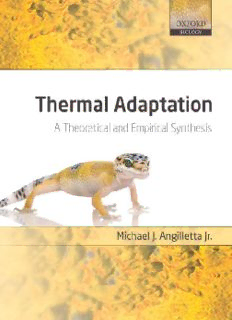
Thermal Adaptation: A Theoretical and Empirical Synthesis PDF
Preview Thermal Adaptation: A Theoretical and Empirical Synthesis
ThermalAdaptation This page intentionally left blank Thermal Adaptation A Theoretical and Empirical Synthesis MichaelJ.AngillettaJr. 1 3 GreatClarendonStreet,Oxfordox26dp OxfordUniversityPressisadepartmentoftheUniversityofOxford. ItfurtherstheUniversity’sobjectiveofexcellenceinresearch,scholarship, andeducationbypublishingworldwidein Oxford NewYork Auckland CapeTown DaresSalaam HongKong Karachi KualaLumpur Madrid Melbourne MexicoCity Nairobi NewDelhi Shanghai Taipei Toronto Withofficesin Argentina Austria Brazil Chile CzechRepublic France Greece Guatemala Hungary Italy Japan Poland Portugal Singapore SouthKorea Switzerland Thailand Turkey Ukraine Vietnam OxfordisaregisteredtrademarkofOxfordUniversityPress intheUKandincertainothercountries PublishedintheUnitedStates byOxfordUniversityPressInc.,NewYork ©MichaelJ.AngillettaJr.2009 Themoralrightsoftheauthorhavebeenasserted DatabaserightOxfordUniversityPress(maker) FirstPublished2009 Allrightsreserved.Nopartofthispublicationmaybereproduced, storedinaretrievalsystem,ortransmitted,inanyformorbyanymeans, withoutthepriorpermissioninwritingofOxfordUniversityPress, orasexpresslypermittedbylaw,orundertermsagreedwiththeappropriate reprographicsrightsorganization.Enquiriesconcerningreproduction outsidethescopeoftheaboveshouldbesenttotheRightsDepartment, OxfordUniversityPress,attheaddressabove Youmustnotcirculatethisbookinanyotherbindingorcover andyoumustimposethesameconditiononanyacquirer BritishLibraryCataloguinginPublicationData Dataavailable LibraryofCongressCataloginginPublicationData Dataavailable TypesetbyNewgenImagingSystems(P)Ltd.,Chennai,India PrintedinGreatBritain onacid-freepaperby CPIAntonyRowe,Chippenham,Wiltshire ISBN 978–0–19–857087–5 978–0–19–857088–2 10 9 8 7 6 5 4 3 2 1 ToAmy, Taylor, and Kyle, for your exceeding tolerance of my wild ideas. This page intentionally left blank Preface ThefirstbookthatIreadasagraduatestudentwas from the paucity of quantitative models of ther- Foraging Theory (Stephens, D. W., and J. R. Krebs. maladaptation.Thermalbiologistshavedescribed 1986, Foraging Theory. Princeton, Princeton Uni- patterns and documented effects to the point that versityPress).Atthetime,Iwasplanningtostudy empirical knowledge has far outstripped theoreti- the evolution of foraging behavior in snakes, and calunderstanding.Mostpapersinthermalbiology thus wanted to acquire a conceptual background focus on empirical descriptions or rely on verbal for this work. As fate would have it, my subse- arguments about adaptation. In comparison, con- quentresearchdidnotfocusonforagingbehavior siderthedisciplineofforagingbiologythatIreferred (orsnakes),butthebookmadealastingimpression toabove;hereinliesatroveofquantitativemodels on me anyway. The authors laid out a compre- andexperimentaltestsaboutevolutionaryhypothe- hensiveandinsightfultheory,movingfromsimple ses.Thebasicideasabouttheevolutionofforaging modelstocomplexones,whiledrawingonrelevant behavior were formulated in the 1960s and have empirical data. The book culminated in a rigor- been gradually developed to the point that the ousappraisalofthefield’saccomplishments,driven evolutionary impacts of many factors—from con- by the match between theoretical predictions and straints on digestion to risks of predation—have empiricalobservations. HadIpursuedmyinterest beenexploredingreatdetail.Fewevolutionarypro- in foraging biology, the book would surely have cessesinthermalbiologyhavebeenmodeledtothe become my academic bible. Instead, I soon devel- samedegree, andnomajorsynthesisofevolution- oped a greater interest in thermal biology, only to arythermalbiologyhasemerged.Myaimisnotto discoverthatnoanalogousresourceexistedforthis castblame(forIwouldcertainlyshareinthisblame). discipline. Rather,Iwanttoseethermalbiologykeeppacewith Idon’twanttogiveyoutheimpressionthatlittle otherbiologicaldisciplines.Andtodoso,wemust wasknownaboutthermalbiologyorthatnoonehad developaquantitativetheoryofthermaladaptation. attemptedaconceptualsynthesis. Neitherimpres- Uponcloserinspection,awealthofevolutionary sionwouldbeaccurate. Inmanyrespects, thermal modelsliewaitingforthermalbiologiststoadoptas biology has progressed tremendously, as one can theirown.BeginningwithLevins(Levins,R.1968, conclude from reading an early synthesis of this EvolutioninChangingEnvironments: SomeTheo- topic(seeCossins,A.R.,andK.B.Bowler.1987,Tem- reticalExplorations.Princeton,PrincetonUniversity peratureBiologyofAnimals.NewYork,Chapman Press), biologists have been modeling the evolu- and Hall). In other respects, though, thermal biol- tionofquantitativetraitsinvariableenvironments ogy continues to lag behind other disciplines. Let for more than four decades. With the growth of me explain. When it comes to documenting pat- thistheory,anincreasingemphasishasbeenplaced terns,fewdisciplineshavemademoreprogressthan on genetic, developmental, and ecological issues. thermal biology. But if we judge progress by our Manyofthemodelscanbeappliedtounderstand understandingoftheprocessesthatgeneratethese aspects of thermal adaptation. Although some of patterns, then we have much progress to make. these models are mathematically intense, I have While proximate explanations abound, ultimate distilled from them the essence of what they tell explanations remain scarce. This problem stems us about adaptation to temperature. For thermal vii viii PREFACE biologists,thisbookcontainsasynthesisoftheory BrandonCooper,LisaCrozier,MarcinCzarnołeski, that should guide research in the coming decade. WilfriedGabriel,GeorgeGilchrist,LumírGvoždík, For evolutionary biologists, the book contains an Gabor Herczeg, Luke Hoekstra, Ray Huey, Jose evaluationofcurrentmodelsofevolutioninvariable Martín, Bill Mitchell, Mike Sears, Ben Williams, environments. andRobbieWilson.Theirsuggestionsandinsights Throughout the book, you may notice a taxo- contributed greatly to the final product. Other nomicbias.Thisbiasstemsfromtwofactors.First, colleagues provided original images or permis- intentionalbiasresultedfrommyconceptualfocus. sion to adapt figures: Martin Ackermann, Steve Thebookrevolvesaroundtheconceptofathermal Beaupre, Gabriel Blouin-Demers, Lauren Buckley, performance curve, which describes the relation- AndyClarke,LisaCrozier,MichaelDillon,Wilfried ship between body temperature and organismal Gabriel, Ted Garland, George Gilchrist, Bruce performance. Most of the book draws on studies Grant,BrianHelmuth,RayHuey,JacobJohansson, of ectotherms because we can measure their per- Joel Kingsolver, Mark Kirkpatrick, Michael Kopp, formancecurvesmorereadilythanwecanmeasure Sue Mitchell, Carlos Navas, Mark New, Camille those of endotherms. Students of endotherms will Parmesan, Steve Piper, Mike Sears, Tim Shreeve, findthemostrelevanttheoreticalandempiricalcon- Gian-RetoWalther,andKazunoriYamahira.Finally, tentinChapter4,butotherchapterscontainrelevant the preparation of this book was greatly acceler- theory.Second,somebiasinevitablyresultsfromthe ated by the help of Angela Borchelt and Phaedra lackofsuitabledataforcertaintaxa.Ineachchapter, Seraphimidi, who obtained copyright permissions I focused on the data most relevant to the theory. forthefiguresadaptedfromothersources. Consequently,certainchaptersarerichwithexam- An undertaking of this magnitude requires the plesinvolvinganimals,plants,ormicrobes,butno supportandencouragementofmanypeople. Iam chapter contains an even coverage of all of these greatlyindebtedtomycolleaguesatIndianaState groups.Ihopethistaxonomicbiasreflectsmyeffort University,whopickeduptheslackformeduring to evaluate the theory more than my ignorance of mysabbatical.Thechairofmydepartment,Charles the literature (although the latter seems inevitable Amlaner,keptmyteachingloadincheckduringthe giventheexponentialgrowthofknowledge). remainderofmywriting.TheLillyFoundationand Aboveall,Itriedtoproducethekindofsynthesis theOfficeoftheProvostatIndianaStateUniversity that I had longed for when I was a graduate stu- providedfinancialsupport. Ioweanequaldebtto dent. If I succeeded in this effort, my success was the students who kept my lab productive despite due partly to the biologists who mentored me in myreallocationofenergyfromresearchtowriting: myformativeyears:JustinCongdon,ArtDunham, DeeAsbury,BrandonCooper,JoeEhrenberger,Matt Henry John-Alder, and Peter Petraitis. My views Schuler, Somayeh Semati, Melissa Storm, and Ben were also shaped by discussions or collaborations Williams. Most of all, I thank my family—Amy, with George Bakken, Lauren Buckley, Ray Huey, Taylor, and Kyle. They kindly endured my crazy Rob James, Joel Kingsolver, Bill Mitchell, Carlos workscheduleandmyoccasionalstressresponses. Navas, Amanda Niehaus, Peter Niewiarowski, Iwouldnothavecompletedthisbookwithouttheir Warren Porter, Leslie Rissler, Mike Sears, Frank patienceandunderstanding. Seebacher, and Robbie Wilson. Many colleagues were kind enough to comment on sections of the MichaelJ.AngillettaJr. book or provide information about their research: May24,2008 David Atkinson, George Bakken, Lauren Buckley, TerreHaute,Indiana,USA Contents Preface vii 1 EvolutionaryThermalBiology 1 1.1 Thechallengeofevolutionarythermalbiology 1 1.2 Thermalreactionnorms 3 1.3 Theroleoftheory 5 1.4 Theoreticalapproachestoevolutionarythermalbiology 6 1.4.1 Optimalitymodels 6 1.4.2 Quantitativegeneticmodels 8 1.4.3 Allelicmodels 10 1.4.4 Thecomplementarityoftheory 13 1.5 Empiricaltoolsoftheevolutionarythermalbiologist 13 1.5.1 Quantifyingselection 14 1.5.2 Experimentalevolution 14 1.5.3 Comparativeanalysis 15 1.6 Conclusions 18 2 ThermalHeterogeneity 19 2.1 Operativeenvironmentaltemperature 20 2.2 Globalpatternsofoperativetemperature 23 2.2.1 Latitudinalclines 23 2.2.2 Altitudinalclines 27 2.3 Quantifyinglocalvariationinoperativetemperatures 29 2.3.1 Mathematicalmodels 29 2.3.2 Physicalmodels 31 2.3.3 Statisticalmodels 32 2.4 Conclusions 33 3 ThermalSensitivity 35 3.1 Patternsofthermalsensitivity 35 3.2 Proximatemechanismsandtradeoffs 40 3.2.1 Thermaleffectsonenzymes(andotherproteins) 41 3.2.2 Membranestructure 43 3.2.3 Oxygenlimitation 44 3.2.4 Conclusionsfromconsideringproximatemechanisms 45 3.3 Optimalperformancecurves 47 3.3.1 Optimalperformancecurves:survivorshipandrelatedperformances 47 3.3.2 Optimalperformancecurves:fecundityandrelatedperformances 51 3.3.3 Contrastingthetwomodels 53 ix
Description: